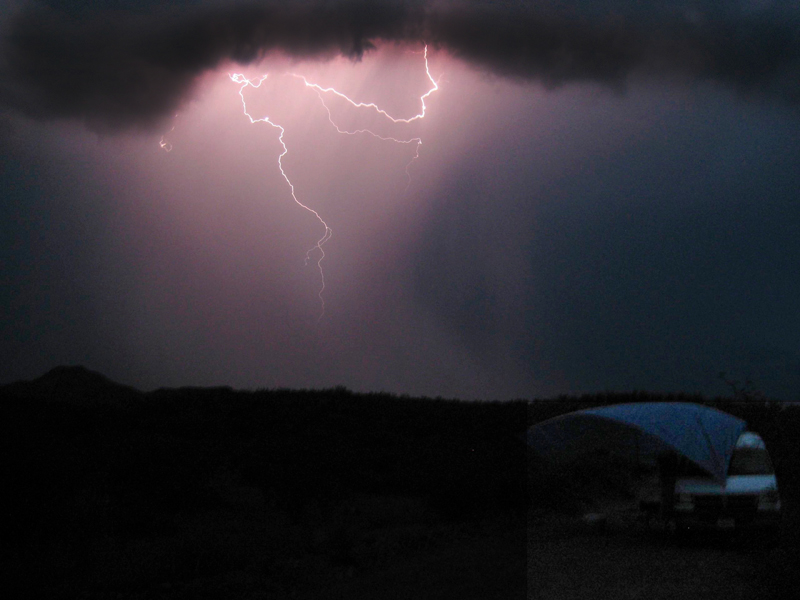Wow, det er et par uger siden mit sidste indlæg, og jeg er lidt flov over at have ladet det gå så længe. Hvad har jeg haft gang i? Ikke en hel ikke. Ingen imponerende samleture, ingen nye arter eller opdagelser. Faktisk har jeg siddet ved et mikroskop og dissekere kønsorganer eller databaseret parasitfluer. Jeg bliver nødt til at lave et opfølgende indlæg for at dykke lidt mere ind i dem…
Men for nu, her er et billedskema i august sidste år. Jeg stod på en åben strækning af Chihuahuan-ørkenen lige uden for Douglas Arizona; en hel kilometer fra den mexicanske grænse. Jeg ankom den aften med min samlerkollega, mikrolepidopteri Peter Jump, og vi havde lige slået lejr, da tordenens rulle nærmede sig. Bortset fra de uddøde kegler, der omgiver os og en lejlighedsvis illegal immigrant, we were the only (and highest) thing around for miles. But the lightening was too hard to resist, I need a picture! But I didn’t have a cable release, nor a tripod, or even a good camera. So what to do… I chose the genius option of standing outside for 40 minutes with my Canon point-and-shoot. I missed 99% of every shot I took, while with every passing minute the lightening grew closer. Endelig, I stumbled upon this decent image. The storm ended up being brief, we huddle in the car (that you can just make out in the picture) while the lightening approached and it drizzled on us for an hour then moved on. Collecting that night was impressive. There were so many moths in the trap that everything had gotten beaten to bits. Det lykkedes mig at redde en håndfuld gode eksemplarer, men lektie lært til næste gang.


Blændende. Jeg har også fundet min bedste sortbelysning, når en storm er under opsejling – ved ikke, hvad det er ved det vejr, der gør insekterne så aktive.
Jeg har lagt mærke til den mærkelige nat her eller der, hvor mølene i fælden så ud til at være usædvanligt rotte, og jeg har undret mig over årsagen og hvordan man kan forhindre det. Det faktum, at det ikke skete hver nat, udelukkede selve fælden som den ultimative årsag, selvom hvis, som du siger, det er på grund af for mange individer inde på én gang, så jeg formoder, at fælden er en del af skylden. Sådan kommer du uden om det? Større fælde? To fælder sammen? Sluk den halvvejs gennem natten? (But what about the late-night flyers?)
I think there are a handful of factors, first and foremost being the percentage of strong flying moths (like Sphingidae) or beetles. But that seems pretty obvious, 40 flapping sphingids in the trap turns it into a vortex, or beetles run around destroying things.
I think it also depends on the killing agent you are using, wind, and how well the trap is sealed. On the most humid of humid nights acetate seems to start failing, where cyanide in the trap would be ideal.
I’m headed to Southern TX in a few weeks and I’ve made some preparations – I’ve built screens that will fit around my traps to keep out the big stuff, and I’ve prepared to have three jars of acetate per trap. Forhåbentlig, that will do it!! The alternative is to completely swap out the traps two or three times over the course of the night, which is something I know people do (sigh).
Back in the day, we used BOTH ethyl acetate and potassium cyanide, because acetate was good for the smaller moths and cyanide provided a faster knock-out of the heavier, destructive, tromping beetles. Moist, wet weather definitely plays a part; you certainly want your trap dry for the equipment, both killing agents to work effectively, and the quality of the catch. We also used a timer for the UV light (both AC and DC) – one of those plug-in varieties that allow you to set the hours of when something should be on and off. This was mainly due to the fact that we had up to 20 traps across 3 counties to set and collect once a week for 4 months every summer for over 10 år. I suspect the timer could easily be adapted to collect at certain or multiple time periods in any given night, depending on your goals.
ps – Chris, what’s this southernfriedscience that I see in your address? If I go to your usual WordPress, Seabrooke and your reply do not show.
That’s a ton of traps! What was this survey work for?
Og- I have moved my entire blog to the southern fried science network, the old wordpress blog will only exist as an archive and no updates will be made. So please change your links to the new page, tak!
Not being a collector (except of photographs), I live trap so the acetate/cyanide wouldn’t be something I’d need to think about. But I can see how beetles and heavy moths could really stir things up. I hadn’t really paid attention to their numbers in the catch on those nights versus others. (I can’t even imagine 40 sphingids in the trap at once! A busy sphinx night for me might be a dozen). Screens are an interesting thought. I wonder how many smaller moths you’d lose by having something they could bump into or land on.
I’m not a collector anymore, either, Seabrooke. Do you have any sample pics of the plates in your new book?
Seabrooke, I found a couple pics of your book plates online. Dejlig! I like the natural poses over pinned and stretched moth specimens. Good job.